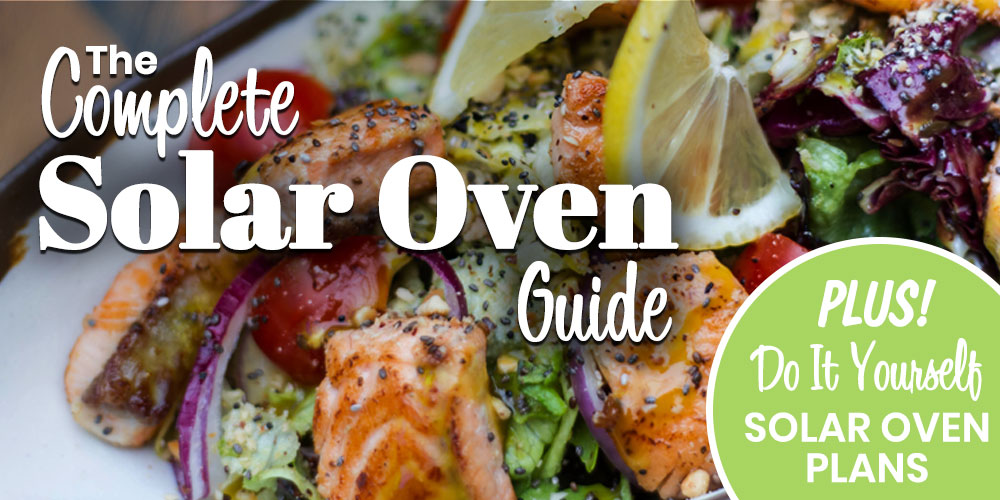
Considering a solar oven? In this comprehensive solar oven guide, I’ll go through everything you need to know about solar ovens and solar cooking. You’ll find comprehensive, honest and unbiased solar oven reviews on every top solar oven available right now, videos explaining my experience testing each solar oven, and even my personal interviews with each solar oven manufacturer. Using this solar oven guide, you’ll find the best solar oven for your needs—or you can even learn how to make a solar oven on your own using simple materials.
Why I Created This Solar Oven Guide
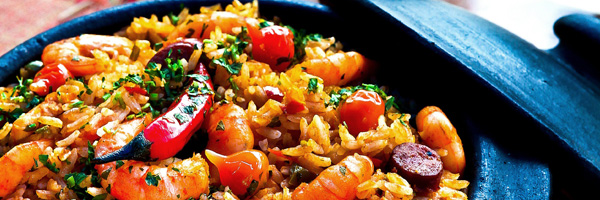
Moving into my tiny house took many adjustments at first. Not only did I downsize, but I also went off the grid. Off-the-grid living presents quite a few challenges—and one of the biggest was how to cook food without electricity. When you rely on solar power, you can only store so much energy in your battery reserve, so I needed to cook food in a low-powered way. My quest led me to explore how to cook using solar ovens and solar cookers: appliances that capture and concentrate the sun’s heat in a box, to cook up delicious dishes—no grid required!
In typical “Ryan fashion,” I couldn’t leave well enough alone. So, I decided to test every major solar oven and cooker on the market to find the perfect solar cooking appliance for me. Because I live totally off the grid, I rely entirely on solar power, so a traditional oven isn’t a possibility. I knew I needed the best solar oven out there. Luckily for you all, I’ll share my comprehensive solar oven reviews and experiences here in this solar oven guide.
What is a Solar Oven and
How Does A Solar Oven Work?

A solar oven uses heat from the sun to cook food. Solar cookers are a great option for camping, survival, emergency preparedness, and small-space living.
Solar ovens, sun ovens, and solar cookers all work using a simple method of capturing the sun’s energy, or rays, and converting the solar power into heat. Typically, solar ovens consist of a very shiny reflector panel, which directs the sun’s rays into a black insulated box. The insulated box of the solar oven absorbs the energy in the form of heat. The heat is trapped inside a chamber with a sealed glass lid and a housing, insulated to reduce heat loss.
The Pros and Cons of Cooking With a Solar Oven

Cooking with the sun is part science, part art form. The closest comparison to solar cooking is cooking with a crockpot, but the process is much more nuanced than a standard slow cooker. Unlike a crock pot, a solar cooker is subject to the availability of the sun. A solar oven requires careful planning—choosing the days you cook. Your timing must be right, meaning you’ll need to keep an eye out for clouds. Conditions aren’t always optimal for using a solar cooker. While a few clouds aren’t a huge issue, overcast weather for part of the day will cut into your cooking time. I must admit, in my three months of testing, there were at least a few occasions where I needed to finish off a dish on the stove or grill, because of cloudy weather.
What many people don’t realize about solar ovens is it’s not an exact science. Solar cooking takes trial, error, and experience to really nail it. You can’t “set” your solar oven to 350 degrees and expect it to maintain a steady temperature. In a few cases, I had to wait to use the solar oven for several days because it rained. Other times, I had to regularly check internal temperatures of food throughout the cooking process, because I wasn’t sure I’d waited long enough.
So yes, cooking in a solar oven isn’t a “set it and forget it” type of convenience cooking. However, after trying out the different solar ovens and experimenting, I found the benefits outweigh the drawbacks.
Pros and Cons of Cooking with the Sun
| Solar Oven Pros | Solar Oven Cons |
|---|---|
| Cooking is pretty simple once you learn how | There is a learning curve |
| You will save money on your power bill | Some ovens are high-priced |
| Perfect for off-grid living, camping or disasters | Not always convenient |
| Reduces your carbon footprint | Dependent on cooperating weather |
| Fun way to cook |
What to Look For in a Solar Cooker
To review the solar ovens fairly and equally, I decided to first outline parameters to measure them. These are the metrics I rated each solar cooker on, to help you determine the best fit for your needs.
 PRICE: I compared the price of each solar oven model I tested. While cost is a major decider for most people, keep in mind, price doesn’t always capture the whole picture.
PRICE: I compared the price of each solar oven model I tested. While cost is a major decider for most people, keep in mind, price doesn’t always capture the whole picture.
 EASE OF USE: I measured how easy it was to cook in each solar oven. I considered the setup time and process. I also measured the ease of checking on foods throughout cooking.
EASE OF USE: I measured how easy it was to cook in each solar oven. I considered the setup time and process. I also measured the ease of checking on foods throughout cooking.
 STORAGE SIZE: In general, all the solar ovens I reviewed were sized to accommodate roasting pans. Size is an important consideration for small space dwellers.
STORAGE SIZE: In general, all the solar ovens I reviewed were sized to accommodate roasting pans. Size is an important consideration for small space dwellers.
 CAPACITY: For each solar oven, I measured how much food could be cooked at once. I also measured the capacity for common items like a loaf of bread or a whole chicken.
CAPACITY: For each solar oven, I measured how much food could be cooked at once. I also measured the capacity for common items like a loaf of bread or a whole chicken.
 DURABILITY: Solar ovens are an investment. I wanted to ensure the ovens I tested could stand the test of time, so I rated each solar cooker on durability.
DURABILITY: Solar ovens are an investment. I wanted to ensure the ovens I tested could stand the test of time, so I rated each solar cooker on durability.
 HEAT POTENTIAL: During my solar oven testing and reviews, I discovered some cookers ran hotter than others. Heat potential is an important factor when you have limited time to cook.
HEAT POTENTIAL: During my solar oven testing and reviews, I discovered some cookers ran hotter than others. Heat potential is an important factor when you have limited time to cook.
 COOKING SPEED: As I tested each solar oven, I found some cooked much faster than others—in several cases the difference was dramatic. Again, this is important when you don’t have time to spend cooking.
COOKING SPEED: As I tested each solar oven, I found some cooked much faster than others—in several cases the difference was dramatic. Again, this is important when you don’t have time to spend cooking.
 PACKAGING: I also considered the packaging. Most solar cookers must be ordered, so how well did the manufacturer protect it during shipping, and were the packing materials eco-friendly?
PACKAGING: I also considered the packaging. Most solar cookers must be ordered, so how well did the manufacturer protect it during shipping, and were the packing materials eco-friendly?
 STANDARD ACCESSORIES: I looked at the accessories that came with each solar oven. Many of the ovens include items to help you cook such as pots, pans and utensils.
STANDARD ACCESSORIES: I looked at the accessories that came with each solar oven. Many of the ovens include items to help you cook such as pots, pans and utensils.
 PORTABILITY: For each solar oven, I considered the portability as well. How easy was it to move the solar cooker around? Was the cooker easy to carry? Was it easy and convenient to store?
PORTABILITY: For each solar oven, I considered the portability as well. How easy was it to move the solar cooker around? Was the cooker easy to carry? Was it easy and convenient to store?
 CARRYING CASE: Many of the ovens also included their own carrying case for added portability. In each review, I documented if the oven came with a case for storing and transporting.
CARRYING CASE: Many of the ovens also included their own carrying case for added portability. In each review, I documented if the oven came with a case for storing and transporting.
Common Accessories for Solar Ovens:
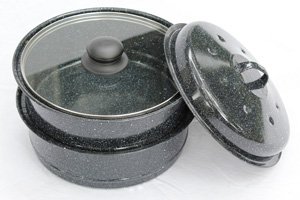 POTS WITH LIDS: Many of the higher tier packages included pots and lids. A few of the base packages also included these great solar oven accessories. Getting the pots is money well spent since they’re often sold in a package and are custom-fit to the solar oven. People who own a lot of pots and baking dishes might not find the extra equipment necessary. For me, as someone without much baking or cooking equipment, ordering the full accessory package (when available) was an easy decision.
POTS WITH LIDS: Many of the higher tier packages included pots and lids. A few of the base packages also included these great solar oven accessories. Getting the pots is money well spent since they’re often sold in a package and are custom-fit to the solar oven. People who own a lot of pots and baking dishes might not find the extra equipment necessary. For me, as someone without much baking or cooking equipment, ordering the full accessory package (when available) was an easy decision.
INTERIOR THERMOMETER: Some of the solar ovens featured a thermometer right in the cooking chamber. This was handy but after getting the hang of solar cooking, it wasn’t necessary. An interior thermometer is a nice extra for the solar ovens to have, but not required.
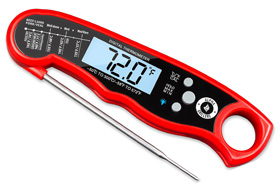 FOOD PROBE THERMOMETER: The food thermometer is one accessory none of the cookers came with. In fact, none of the manufacturers even sell them as an add-on in their stores, which I find puzzling. A food probe thermometer is critical to check the internal temperature of meats. Of this entire list, this is the only accessory that’s an absolute must. The good news is you can buy a basic food probe thermometer at most stores or online for $10-$15.
FOOD PROBE THERMOMETER: The food thermometer is one accessory none of the cookers came with. In fact, none of the manufacturers even sell them as an add-on in their stores, which I find puzzling. A food probe thermometer is critical to check the internal temperature of meats. Of this entire list, this is the only accessory that’s an absolute must. The good news is you can buy a basic food probe thermometer at most stores or online for $10-$15.
CARRYING CASE: Some of the solar ovens came with a case, while others didn’t offer this extra. I really liked the carrying cases, personally. A stove, a reflector, a few pots, and a rack or two are cumbersome to carry. A nice, sturdy case makes it easy to move your cooking gear and easy to store all the items when you’re not using them.
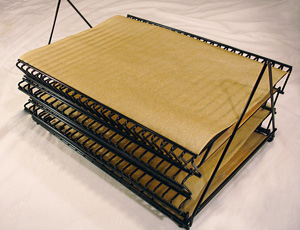 DEHYDRATING RACKS: I don’t do much food dehydrating, but I was impressed with the quality of the drying racks provided with some of the solar ovens. The food dehydrating racks were very sturdy. They also stacked well to maximize how much you dehydrate at one time. If you’re someone who enjoys food preservation and dehydrating, the racks are a worthwhile investment. I haven’t seen any like them in stores.
DEHYDRATING RACKS: I don’t do much food dehydrating, but I was impressed with the quality of the drying racks provided with some of the solar ovens. The food dehydrating racks were very sturdy. They also stacked well to maximize how much you dehydrate at one time. If you’re someone who enjoys food preservation and dehydrating, the racks are a worthwhile investment. I haven’t seen any like them in stores.
WAPI: This is a simple little device used by campers, survivalists, preppers, and outdoor enthusiasts. It’s a little vial of wax to float in water as it’s heated. Once the wax melts and flows to the bottom of the vial, you know the water is safe to drink. This is inexpensive and a good tool for campers or those who want the stove for disasters.
What’s the Best Solar Oven Design?
I personally tested each of the following solar ovens over several months, cooking different dishes. I wanted to truly see how each oven worked in the real world, to determine the best solar cooker for various situations. Solar cookers aren’t a one-size-fits-all appliance. For each oven, I did a full review with plenty of details. Below you’ll find a summary of the recommendations to help you choose.
The Solar Ovens I Tested:
- All American SUN OVEN
- GoSun Sport Solar Oven
- GoSun Fusion Hybrid Solar Oven
- GoSun Go Portable Solar Oven
- Sunflair Solar Oven
- Solavore Sport Solar Oven
- UGLI Hybrid Solar Electric Oven
- SunFocus Solar Hybrid Oven
Which Solar Oven Should You Buy?
For one or two people:
For a family or group:
For the budget-conscious:
For those who need a portable oven:
For Campers:
For those who want all the bells and whistles:
Solar Oven Specs
| Brand | Price | Size | Capacity | Stored Size | Carrying Case |
|---|---|---|---|---|---|
| All-American Sun Oven | $349-$399 | 19x19x14 without reflector | Large | 19x19x14 | None |
| GoSun | $249 – $359 | 24x16x12 | Small | 24x8x5 | Yes, additional cost |
| Sunflair | $89-$165 | 19x16x18 without reflector | Medium | 16x2x19 | Yes, included |
| Solavore | $199-$287 | 17x27x12 without reflector | Large | 17x27x12 | Yes, included |
| Ugli Hybrid | $389 | 22x22x12 lid closed |
Large | 22x22x12 | Integrated |
| Sun Focus | $599 | 22x22x12 lid closed |
Large | 22x22x12 | Integrated |
Solar Oven Ratings
| Ease of Use | Durability | Heat Potential | Cooking Speed | Packaging | Portability | Accessories |
|---|---|---|---|---|---|---|
| All-American Sun Oven | ||||||
| GoSun | ||||||
| Sunflair | ||||||
| Solavore | ||||||
| Ugli Hybrid | None | |||||
| Sun Focus | None |
In-Depth Reviews
All-American Sun Oven Review
 The All American SUN OVEN is a very popular solar cooker option. Everyone I know who has tried the SUN OVEN gives it a positive review. However, I feel like people just default to this oven and don’t seriously consider other options. Of all the solar ovens I tested, the SUN OVEN was the largest and heaviest. It is well-equipped with a lot of extras and features. You can tell the manufacturer put a lot of thought into this solar oven. It’s at the top of the price range but it’s a good value. If you’re considering investing in a long-lasting solar oven, I recommend the SUN OVEN.
The All American SUN OVEN is a very popular solar cooker option. Everyone I know who has tried the SUN OVEN gives it a positive review. However, I feel like people just default to this oven and don’t seriously consider other options. Of all the solar ovens I tested, the SUN OVEN was the largest and heaviest. It is well-equipped with a lot of extras and features. You can tell the manufacturer put a lot of thought into this solar oven. It’s at the top of the price range but it’s a good value. If you’re considering investing in a long-lasting solar oven, I recommend the SUN OVEN.GoSun Sport Solar Oven Review
 The GoSun Sport Solar Oven was the cooker I was most skeptical of when I started my testing, but due to the unique design, I felt a review of the top solar ovens wouldn’t be complete without including it. To put it plainly, my reservations were quickly overturned, and this was one of my favorite solar cookers of the entire test.
The GoSun Sport Solar Oven was the cooker I was most skeptical of when I started my testing, but due to the unique design, I felt a review of the top solar ovens wouldn’t be complete without including it. To put it plainly, my reservations were quickly overturned, and this was one of my favorite solar cookers of the entire test.Sunflair Solar Oven Review
 I was very curious about the Sunflair Solar Oven because of the unique way it breaks down to be small and very portable. Of all the ovens I tested, the Sunflair Solar Oven was the most portable, and the easiest to move and store. Additionally, it was the least expensive, but that isn’t to say it was cheap. It was well made and recognizing it for what it is, I think people will consider this a good option.
I was very curious about the Sunflair Solar Oven because of the unique way it breaks down to be small and very portable. Of all the ovens I tested, the Sunflair Solar Oven was the most portable, and the easiest to move and store. Additionally, it was the least expensive, but that isn’t to say it was cheap. It was well made and recognizing it for what it is, I think people will consider this a good option.Solavore Sport Solar Oven Review
 The Solavore Sport Solar Oven is another very popular solar oven. A few of my friends purchased the Solavore to cook off grid. It includes a nice case which is a really nice addition. The oven package is priced at the upper tier ($287) but includes a nice additional set of pots. The one unique aspect of this oven over others is that you can cook two pots side by side. I like this approach better than the other stoves, which required stacking pans vertically. Having two pots lets you cook your main dish and a side dish at once, which is very practical in many people’s cooking.
The Solavore Sport Solar Oven is another very popular solar oven. A few of my friends purchased the Solavore to cook off grid. It includes a nice case which is a really nice addition. The oven package is priced at the upper tier ($287) but includes a nice additional set of pots. The one unique aspect of this oven over others is that you can cook two pots side by side. I like this approach better than the other stoves, which required stacking pans vertically. Having two pots lets you cook your main dish and a side dish at once, which is very practical in many people’s cooking.UGLI Hybrid Solar-Electric Oven & Sunfocus Solar Hybrid Oven Review
 The SunFocus and the UGLI hybrid solar ovens are truly an oven of a different breed, which is exactly why I wanted to include them in my testing. The big differentiator between these ovens and the others I tested, is that these are hybrid solar electric ovens.
The SunFocus and the UGLI hybrid solar ovens are truly an oven of a different breed, which is exactly why I wanted to include them in my testing. The big differentiator between these ovens and the others I tested, is that these are hybrid solar electric ovens.
They’re used as solar ovens, but they can be plugged in if the clouds roll in or for cooking after the sun has set. As anyone who’s cooked with solar knows, this aspect is a nice feature. With other solar ovens, there were several times when I had to fire up the grill to finish off meats that didn’t get enough cook time.
To simplify this review, understand these are essentially the same oven, but in different housings. The UGLI Oven (pronounced ug-lee) is essentially a budget version of the SunFocus. The SunFocus had the best case of all the ovens I tested. So, between the two of them I’d spring for the nicer housing of the SunFocus. This hybrid solar oven is built well and would hold up even if it was left out in the rain.
How to Build A Solar Oven: DIY Solar Cooker Plans
Building your own solar oven isn’t difficult, but it’s a detailed process. Here are the basic steps to DIY a solar cooker for cheap—and building your own solar oven is a great way to save money. A solar cooker is also a fun project to do with kids and makes a great school science project.
When it comes to building your own solar cooker, there are three main factors you need to get right:
- A well-insulated, dark-colored box
- A method for sealing the glass onto the top of the box
- A highly reflective, decent-sized surface
If you get these three solar oven details right, you’ll be cooking in no time.
The Steps for Building a Solar Oven
Below, I outline the main steps of how to build a solar oven. For more detailed instructions and free plans, scroll down to download.
STEP 1: Gather your accessories and find a piece of glass (single pane) to use for your DIY solar oven.
STEP 2: Match the size of your box to the piece of glass, allowing for room to seal the glass to the box. This will form the base of your homemade solar cooker.
STEP 3: Gather or build two boxes, an outer box (16” tall) and inner box (13.5” tall). The smaller box should fit inside the larger box with a 1” gap on all sides.
STEP 4: Cut and insert a 1” foam board on the inside of the “outer box” on all sides. This is to form the insulation for your DIY solar cooker.
STEP 5: Insert the inner box of your solar oven. Once inserted, the inner box should sit snuggly within the foam.
STEP 6: Using high temperature-friendly paint (such as barbecue/grill paint), paint the box inside and out Be sure to tape or mask-off the foam so it doesn’t get painted.
STEP 7: Add a weather strip seal around the top edge of the box. Make sure that when the glass is laid on top of the box, it seals tightly.
STEP 8: Set the painted box outside in direct sun to bake off any chemical fumes from the paint. Allow it to completely dry.
STEP 9: Cut 4 pieces of plywood to create the reflector panels. The plywood should be the same length as your outer box dimension and 12” wide.
STEP 10: Use small hinges to attach reflector panels to the top of the outer box. The hinges should be set to fold down, away from the box.
STEP 11: Check to make sure you can still take the glass on and off the solar oven box, even with the reflectors on.
STEP 12: Apply a shiny surface to the reflector panels. Use any reflective material such as tinfoil, a cut mirror or shiny aluminum sheets.
STEP 13: Attach eye hooks to the sides of the reflectors. This will allow you to adjust the reflectors on your DIY solar oven using string.
STEP 14: Place your solar cooker in the direct sun. Use brick to prop up the back edge. Adjust the reflectors to shine into the box.
Those are the basic steps of making your own solar oven. Of course, there are more details and as they say, a picture’s worth a thousand words. I’ve put together a set of FREE solar oven designs and plans with step-by-step, detailed instructions. These free solar oven plans include plenty of graphics to walk you through each step, as well as a detailed material list. To download these free make your own solar oven plans, simply join our mailing list below:
Frequently Asked Questions About Cooking with Solar Ovens
What can I cook in a solar oven?
Almost any food you can cook in a traditional oven can also be prepared in a solar cooker. When I was testing each oven, I cooked meat, potatoes, veggies, soups, stews, bread and much more. I tried a wide variety in all the ovens to get a good feel for their capacity. A solar oven yields similar results to food from a crockpot or slow cooker. The added benefit of a solar oven is that once you cook food through, you can open the cover, venting steam. This allows your food to brown and crisp up.
How hot do solar ovens get?
Solar ovens typically reach 250-350 degrees on a sunny day. During my tests, certain ovens ran cooler than others (which I’ve outlined in the reviews). Solar ovens are hot enough to thoroughly cook food.
How long does it take to cook in a solar oven?
Cooking times really depend on the item you’re cooking and the size. For example, a whole baked potato will take most of the day, while a diced potato may only take 1-2 hours. Leafy greens take an hour or less. Chicken breasts, steaks, sausages, or whole chickens will take 4-6 hours of good sun. Breads bake in 1-3 hours depending on the sun.
Is it hard to aim and adjust a solar oven?
Each oven requires trial and error to figure out, but the cooking process is rather intuitive. Some of the solar ovens feature indicators to assist with adjustments, which are helpful. In general, reading the manual first will help immensely. After that, simply try it out and adjust as you go. Even if a dish doesn’t seem to be cooking perfectly, the process is pretty forgiving. The best practice is to adjust every 30 minutes or so (but honestly, sometimes I was too lazy to adjust that often and my food turned out fine).
Do you need special pots and pans for a solar cooker?
To bake or cook foods in a solar oven, almost any cooking pan can be used. Even cooking food in tinfoil will work. If you’re new to solar cooking, I recommend opting for the pans the manufacturer sells, as they’re custom-made to fit the oven. In general, you want dark pots and pans, ideally with thinner walls.
Does food need to be stirred when you use a solar cooker?
Honestly, I didn’t even worry about stirring when I cooked. Because the box is fairly open, solar cookers give off very even heat. In this way, cooking with a solar oven is very similar to a crock pot. The cooking process is hands-off, other than turning the ovens every now and then to get more sun.
Can I cook multiple dishes in my solar oven at the same time?
Yes! I often cook several dishes at once in my solar cooker. The key is to simply get your cooking times right. When I first started, some foods ended up overcooked while I was waiting for others to finish. To help keep cooking times consistent, use small silicone cups to segment the foods. Cut larger (slower cooking) items into small pieces, while leaving faster cooking foods in large pieces or whole.
Can I cook in a solar oven in the winter?
Absolutely! With the solar oven, it’s about sun over heat. To cook in the winter months, capture those bright sun rays and aim them into the solar cooker. Keep in mind cooking times might take a little longer in the winter. Of course, you’ll want to avoid cooking on stormy, windy days when the reflectors might blow over. No matter the weather, always use a thermometer to check for proper internal food temps.
Can I use a solar oven to dehydrate foods?
Of course! Dehydrating foods requires low, slow heat—perfect for a solar cooker. The ability to make great dehydrated foods is a standout feature of these sun ovens. The key to keeping foods dry is to make sure the cover or glass is slightly open, so the moisture escapes.
If you’re ready to give solar ovens a shot, check out the individual reviews to choose the oven that’s best for you. Whether you decide to make a DIY sun oven or purchase a solar cooker, the process is a fun, enjoyable and interesting way to cook. If you like experimenting with outdoor and small space cooking, you’ll love solar ovens!

